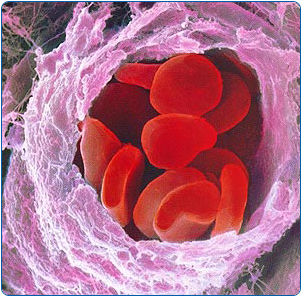Citrated samples of blood can be reconstituted by adding 20µl of CaCl2 (CiTEMA) in the cup before pipetting 340µl of blood in it. The test should be run within a maximum of four hours from draw and the following will affect the results : it is important not to mix the sample before the test, but only immediately before it by inversion 5 times; the handling with two reagents of unknown effect on the mechanical behaviour of blood, which is assumed to produce a constant bias; the permanence of the sample for quite a time not at body temperature, even if re-heated, will produce results not comparable to those on native blood and will depend on the amount of time the sample has not been warmed.
Special analysis
Caolin (FasTEMA) is a contact activator of the intrinsic pathway of coagulation being formed, by a mineral powder suspended in distilled water.
As the blood enters in contact with the micro parts of the suspension, the coagulation process will be accelerated. This reagent will save approximately one half of the time required to determine the parameter R, it is therefore useful in the presence of a situation of suspect hypo-coagulation, probably with the patient bleeding, to obtain a quicker answer. Note that the R parameter reflects the work of Thrombin, AT and fibrinogen and in minor part that of platelets. Note also that the measure of the R parameter of a blood sample differs substancially if exposed to caolin or not. And note also that this is the parameter that suffer most from inter-operator variances. Therefore any clinical decision should carefully take these factors into consideration.

Citocalasyn/Abciximab : A reagent based on Citocalasyn-D (FibCheck) can be used in the cup, mixing with blood, to explore the fibrinogen activity. It is alternatively possible to add abciximab (ReoPro ®) in the TEM-A cup before pipetting the blood sample into it. The presence of one of these reagents will abrogate the activity of the platelets and the resulting parameters can be referred to the exclusive activity of fibrinogen. Comparing two tests, one with and one without Citocalasyn/abiciximab, the difference in Maximum Amplitude will measure the contribution of platelets to the clot. Scientific literature debates on which of these two reagents is best, i.e. will abrogate an improved amount of platelets in order to be able to quantify the fibrinogen presence in the sample. So far, the most reliable parameter is the percentage reduction of MA in respect to the MA obtained without reagent.
Tissue Factor : the addition of diluted Tissue Factor (ExWay) to the blood sample will rapidly activate the extrinsic pathway of coagulation, reducing the Reaction Time to few seconds and therefore create a thromboelastogram with an almost immediate MA. It provides an MA parameter in few minutes. It can be used in conjunction with other reagents as well. Careful consideration should be given to the fact that TF may alter the MA and other parameters.
Platelet Aggregation: a complex combination of tests, 3 to 4, involving several reagents can reveal to which native aggregation a certain percentage reduction caused by antiaggregant therapy has been applied. This test can also be applied to detect aspirin activity. These tests require the contemporaneous availability of more than 2 modules and can be run quite easily in the lab using commercial reagents and following the published protocols. Running them properly in the OR/ICU environment would be very demanding on personnel that is not accustomed nor trained in the exactitude of lab procedures.
